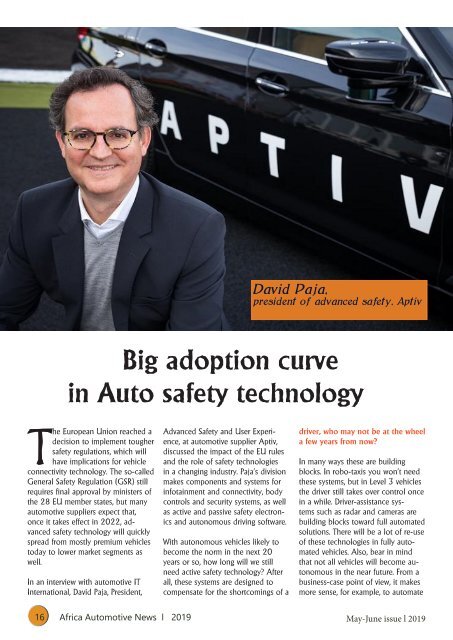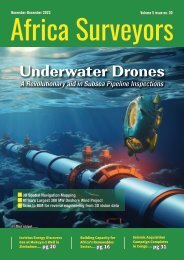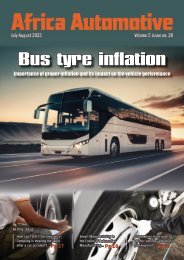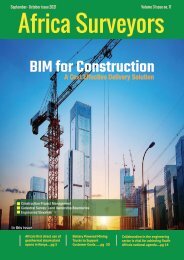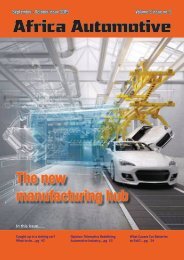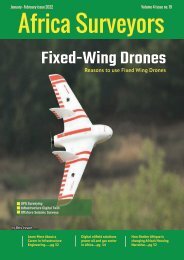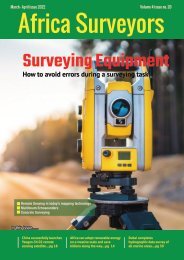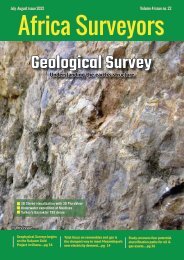Africa Automotive May-June digital issue 2019
Africa Automotive prides itself to be the ONLY Africa’s leading and MOST authoritative magazine for the automotive industry in Africa with printed copies for the automotive industry decision makers in both government, NGO’s and private sector. The Bi-monthly magazine offers cost effective advertising services that get results and improves growth in the auto B2C and B2B sector, keeping an eye on latest technologies in Africa and across the world, the magazine predominately covers the developments in the Africa auto industry.
Africa Automotive prides itself to be the ONLY Africa’s leading and MOST authoritative magazine for the automotive industry in Africa with printed copies for the automotive industry decision makers in both government, NGO’s and private sector. The Bi-monthly magazine offers cost effective advertising services that get results and improves growth in the auto B2C and B2B sector, keeping an eye on latest technologies in Africa and across the world, the magazine predominately covers the developments in the Africa auto industry.
You also want an ePaper? Increase the reach of your titles
YUMPU automatically turns print PDFs into web optimized ePapers that Google loves.
David Paja,<br />
president of advanced safety, Aptiv<br />
Big adoption curve<br />
in Auto safety technology<br />
The European Union reached a<br />
decision to implement tougher<br />
safety regulations, which will<br />
have implications for vehicle<br />
connectivity technology. The so-called<br />
General Safety Regulation (GSR) still<br />
requires final approval by ministers of<br />
the 28 EU member states, but many<br />
automotive suppliers expect that,<br />
once it takes effect in 2022, advanced<br />
safety technology will quickly<br />
spread from mostly premium vehicles<br />
today to lower market segments as<br />
well.<br />
In an interview with automotive IT<br />
International, David Paja, President,<br />
Advanced Safety and User Experience,<br />
at automotive supplier Aptiv,<br />
discussed the impact of the EU rules<br />
and the role of safety technologies<br />
in a changing industry. Paja’s division<br />
makes components and systems for<br />
infotainment and connectivity, body<br />
controls and security systems, as well<br />
as active and passive safety electronics<br />
and autonomous driving software.<br />
With autonomous vehicles likely to<br />
become the norm in the next 20<br />
years or so, how long will we still<br />
need active safety technology? After<br />
all, these systems are designed to<br />
compensate for the shortcomings of a<br />
driver, who may not be at the wheel<br />
a few years from now?<br />
In many ways these are building<br />
blocks. In robo-taxis you won’t need<br />
these systems, but in Level 3 vehicles<br />
the driver still takes over control once<br />
in a while. Driver-assistance systems<br />
such as radar and cameras are<br />
building blocks toward full automated<br />
solutions. There will be a lot of re-use<br />
of these technologies in fully automated<br />
vehicles. Also, bear in mind<br />
that not all vehicles will become autonomous<br />
in the near future. From a<br />
business-case point of view, it makes<br />
more sense, for example, to automate<br />
16 <strong>Africa</strong> <strong>Automotive</strong> News l <strong>2019</strong> <strong>May</strong>-<strong>June</strong> <strong>issue</strong> l <strong>2019</strong>


